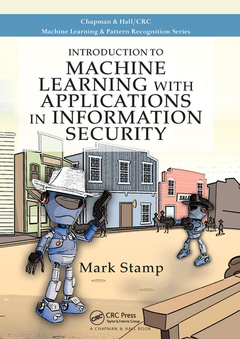Introduction to Machine Learning with Applications in Information Security Chapman & Hall/CRC Machine Learning & Pattern Recognition Series
Auteur : Stamp Mark

Introduction to Machine Learning with Applications in Information Security provides a class-tested introduction to a wide variety of machine learning algorithms, reinforced through realistic applications. The book is accessible and doesn?t prove theorems, or otherwise dwell on mathematical theory. The goal is to present topics at an intuitive level, with just enough detail to clarify the underlying concepts.
The book covers core machine learning topics in-depth, including Hidden Markov Models, Principal Component Analysis, Support Vector Machines, and Clustering. It also includes coverage of Nearest Neighbors, Neural Networks, Boosting and AdaBoost, Random Forests, Linear Discriminant Analysis, Vector Quantization, Naive Bayes, Regression Analysis, Conditional Random Fields, and Data Analysis.
Most of the examples in the book are drawn from the field of information security, with many of the machine learning applications specifically focused on malware. The applications presented are designed to demystify machine learning techniques by providing straightforward scenarios. Many of the exercises in this book require some programming, and basic computing concepts are assumed in a few of the application sections. However, anyone with a modest amount of programming experience should have no trouble with this aspect of the book.
Instructor resources, including PowerPoint slides, lecture videos, and other relevant material are provided on an accompanying website: http://www.cs.sjsu.edu/~stamp/ML/. For the reader?s benefit, the figures in the book are also available in electronic form, and in color.
About the Author
Mark Stamp has been a Professor of Computer Science at San Jose State University since 2002. Prior to that, he worked at the National Security Agency (NSA) for seven years, and a Silicon Valley startup company for two years. He received his Ph.D. from Texas Tech University in 1992. His love affair with machine learning began in the early 1990s, when he was working at the NSA, and continues today at SJSU, where he has supervised vast numbers of master?s student projects, most of which involve a combination of information security and machine learning.
Introduction
What is Machine Learning?
About This Book
Necessary Background
A Few Too Many Notes
I TOOLS OF THE TRADE
A Revealing Introduction to Hidden Markov Models
Introduction and Background
A Simple Example
Notation
The Three Problems
The Three Solutions
Dynamic Programming
Scaling
All Together Now
The Bottom Line
A Full Frontal View of Profile Hidden Markov Models
Introduction
Overview and Notation
Pairwise Alignment
Multiple Sequence Alignment
PHMM from MSA
Scoring
The Bottom Line
Principal Components of Principal Component Analysis
Introduction
Background
Principal Component Analysis
SVD Basics
All Together Now
A Numerical Example
The Bottom Line
A Reassuring Introduction to Support Vector Machines
Introduction
Constrained Optimization
AC loser Look at SVM
All Together Now
A Note on Quadratic Programming
The Bottom Line
Problems
A Comprehensible Collection of Clustering Concepts
Introduction
Overview and Background
-Means
Measuring Cluster Quality
EM Clustering
The Bottom Line
Problems
Many Mini Topics
Introduction
-Nearest Neighbors
Neural Networks
Boosting
Random Forest
Linear Discriminant Analysis
VectorQuantization
Naïve Bayes
Regression Analysis
Conditional Random Fields
Data Analysis
Introduction
Experimental Design
Accuracy
ROC Curves
Imbalance Problem
PR Curves
The Bottom Line
II APPLICATIONS
HMM Applications
Introduction
English Text Analysis
Detecting "Undetectable" Malware
Classic Cryptanalysis
PHMM Applications
Introduction
Masquerade Detection
Malware Detection
PCA Applications
Introduction
Eigenfaces
Eigenviruses
Eigenspam
SVM Applications
Introduction
Malware Detection
Image Spam Revisited
Clustering Applications
Introduction
-Means for Malware Classification
EM vs -Means for Malware Analysis
Mark Stamp is a Professor at San Jose State University, and the author of two textbooks, Information Security: Principles and Practice and Applied Cryptanalysis: Breaking Ciphers in the Real World.
Date de parution : 06-2020
15.6x23.4 cm
Disponible chez l'éditeur (délai d'approvisionnement : 14 jours).
Prix indicatif 53,83 €
Ajouter au panierDate de parution : 09-2017
15.6x23.4 cm
Disponible chez l'éditeur (délai d'approvisionnement : 14 jours).
Prix indicatif 78,14 €
Ajouter au panierThèmes d’Introduction to Machine Learning with Applications in... :
Mots-clés :
Profile Hidden Markov Models; Malware Samples; Malware Family; Malware Detection; SVM Training; Benign Samples; Gap Penalty Function; PCA Score; Em Cluster Algorithm; Masquerade Detection; Forward Algorithm; Random Restarts; Metamorphic Malware; Linear SVM; Standard Dataset; Ham Images; Malware Detection Technique; SVM; Roc Curve; HMM; Pairwise Alignments; PR Curve; Em Algorithm; Pairwise Alignment Scores; Putative Key
